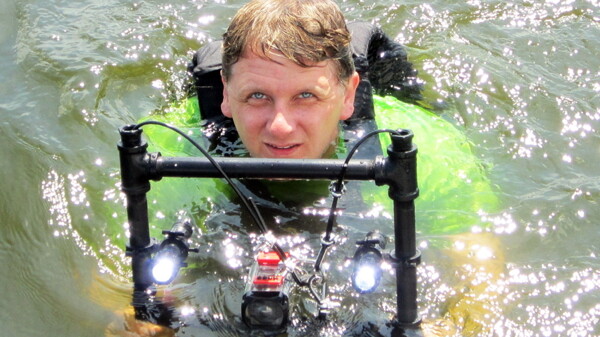A Monster of a Legend
Chad Lewis explores Lake Pepin monster tales

mission to Lake Pepin.
After 20 years of probing the paranormal through thousands of investigations, hundreds of lectures, and 17 books, Chad Lewis is finally a believer.
Well, almost.
Lewis, an Eau Claire native and UW-Stout grad who made a name for himself systematically investigating things that go bump in the night, has always ridden the line between wide-eyed credulity and narrow-minded skepticism. Whether the subject has been the Caryville ghost or the Chupacabra of Latin America, Lewis has always stayed on the fence between those who accept paranormal phenomena as a fact of life and those who dismiss it as fable. “Love it or hate it, my fallback is always 50/50,” Lewis says. “After 20 years of doing this, I’m left with more questions than answers.”
However, after several years of investigation, Lewis says he’s sure – at least 75 percent sure – that there’s truth behind the latest legend he has explored: “Pepie,” an unidentified aquatic beast living in the waters of Lake Pepin.
Descriptions of the beast vary widely: Some say it resembles an eel or a worm, while others describe it as looking much like Nessie – or, if you prefer, a prehistoric plesiosaur.
“This is probably the first time I thought it pushed me above the 50/50 mark,” he says of the information he gathered while penning Pepie: The Lake Monster of the Mississippi River, which was published this month. What moved the needle on Lewis’ Skeptic-O-Meter, he says, is the quality and believability of lore about the lake monster, which ranges from early Native American tales to contemporary sightings of something large and unusual in the lake.
Don’t feel sheepish if, like me, you’ve never heard of Pepie. Like its cryptozoological cousins in Loch Ness, Lake Champlain, and elsewhere around the world, stories of Pepie date back centuries. However, unlike tales of those other creatures, until recently the legend of Pepie didn’t expand much beyond the vast, scenic lake on the Minnesota-Wisconsin border. In fact, despite having assembled a list of Wisconsin aquatic oddities for a previous book, Lewis himself hadn’t heard of Pepie until 2008, when a lakeside businessman made headlines with a startling proposition: He’d pay $50,000 to anyone who could prove the lake monster existed. The promoter is Larry Nielson of Lake City, Minn., who owns a hotel on the lake as well as a paddle wheeler, Pearl of the Lake, that plies its waters. Nielson latched onto the eerie stories as a way to boost tourism: “If you come here looking for the monster and you don’t find it, at least you’ll get a great vacation,” is how Lewis describes Nielson’s attitude.
Lewis and co-author Noah Voss researched the Pepie stories extensively. They learned that Native Americans feared a sea serpent living in Lake Pepin’s waters and would only take their largest and strongest canoes onto the lake. Such tales and sightings continued into the era of European exploration and settlement. The most well-known sighting came in 1871, when two men claimed to have seen “a marine monster, between the size of an elephant and a rhinoceros, which moves through the water with great rapidity.”
Sightings have continued up to the present day – and even a few fuzzy photos have surfaced – but descriptions of the beast vary widely: Some say it resembles an eel or a worm, while others describe it as looking much like Nessie – or, if you prefer, a prehistoric plesiosaur. Lewis catalogues numerous eyewitness reports from recent years, including an intriguing one from a lakeside cabana owner who spied a 30-foot creature with a snakelike head. The incident changed how the man conducted his pontoon-boat tours: Shaken by the sighting and fearing for his guests’ safety, he no longer stops to allow tourists to swim in the middle of the lake.
Lewis acknowledges that many of the sightings can be explained as misidentifications of floating logs, lateral waves, or well-documented species, such as the longnose gar, catfish, or sturgeon. Or perhaps witnesses have seen a giant aquatic tourist, such an alligator gar or a bull shark (both of which have been spotted in the Mississippi as far north as Illinois.)
However, he contends, mistaken identity might not explain all of the sightings described in the book: “People say they’ve seen a neck 8 feet out of the water,” Lewis says. “They’re probably not misidentifying a lake sturgeon.”
Lewis took part in two Pepie-hunting expeditions – in 2011 and 2013 – but came up empty-handed despite using sonar and underwater cameras. Nonetheless, he hopes readers get hooked on the “hokey fun” of the Pepie legend. After all, millions have fallen in love with Nessie, whose reputed home, like Lake Pepin, is long, narrow, and surrounded by green bluffs. Floating on Lake Pepin, “If you had some Scotch whisky, you might think you were in Loch Ness,” Lewis quips. Maybe the monster thinks so, too.
 Pepie: The Lake Monster of the Mississippi River by Chad Lewis and Noah Voss is available at The Local Store, 205 N. Dewey St., and online at ChadLewisResearch.com and Amazon.com.
Pepie: The Lake Monster of the Mississippi River by Chad Lewis and Noah Voss is available at The Local Store, 205 N. Dewey St., and online at ChadLewisResearch.com and Amazon.com.






















